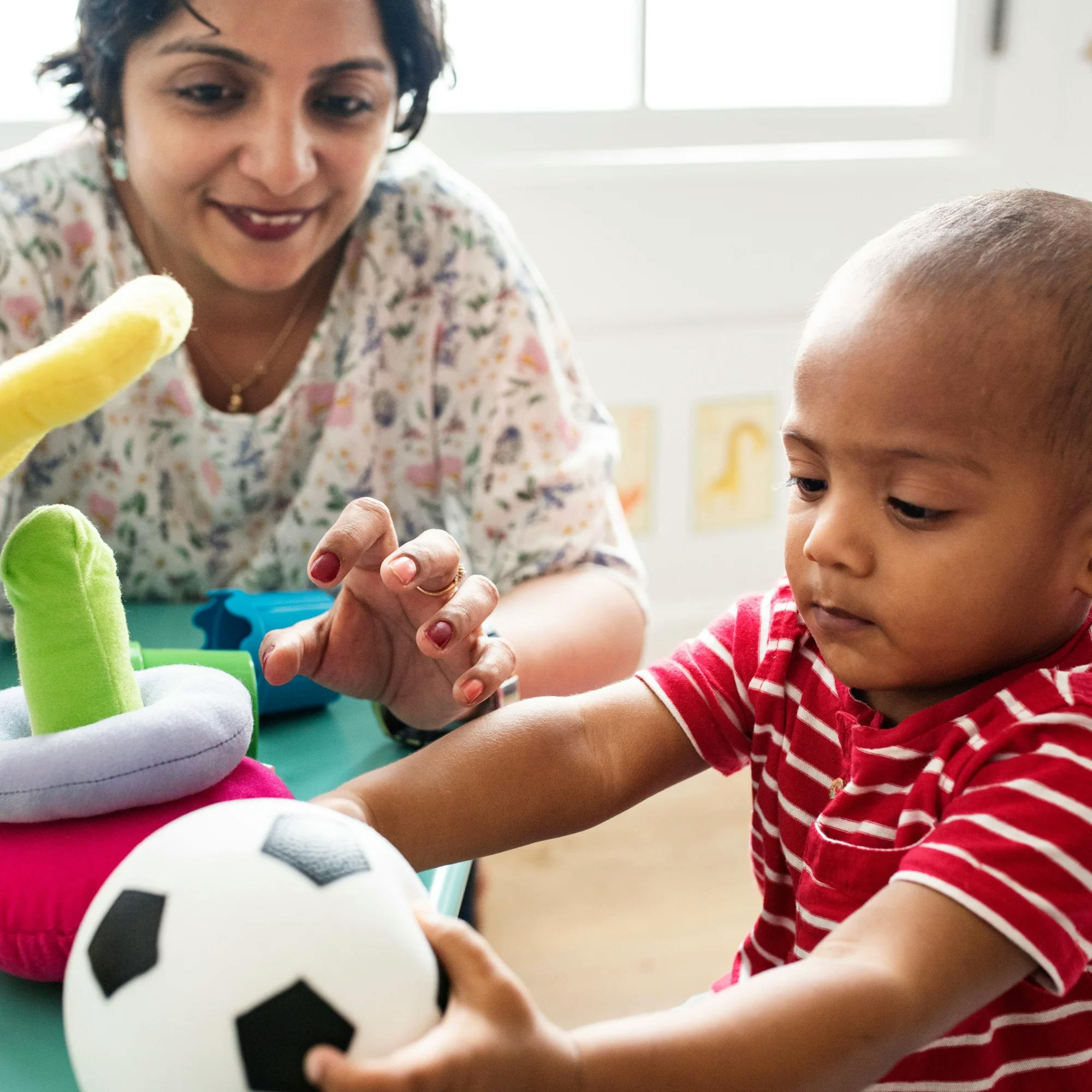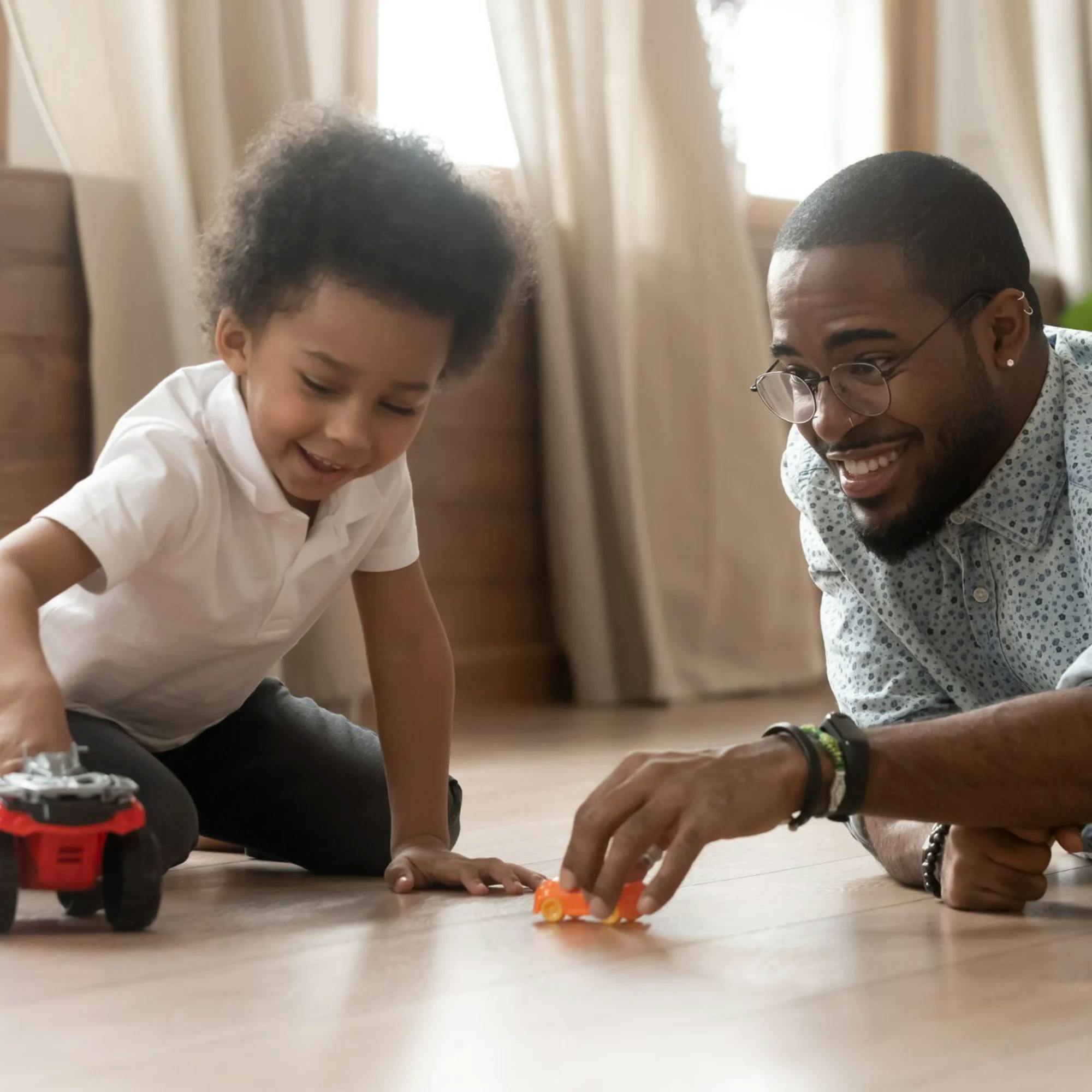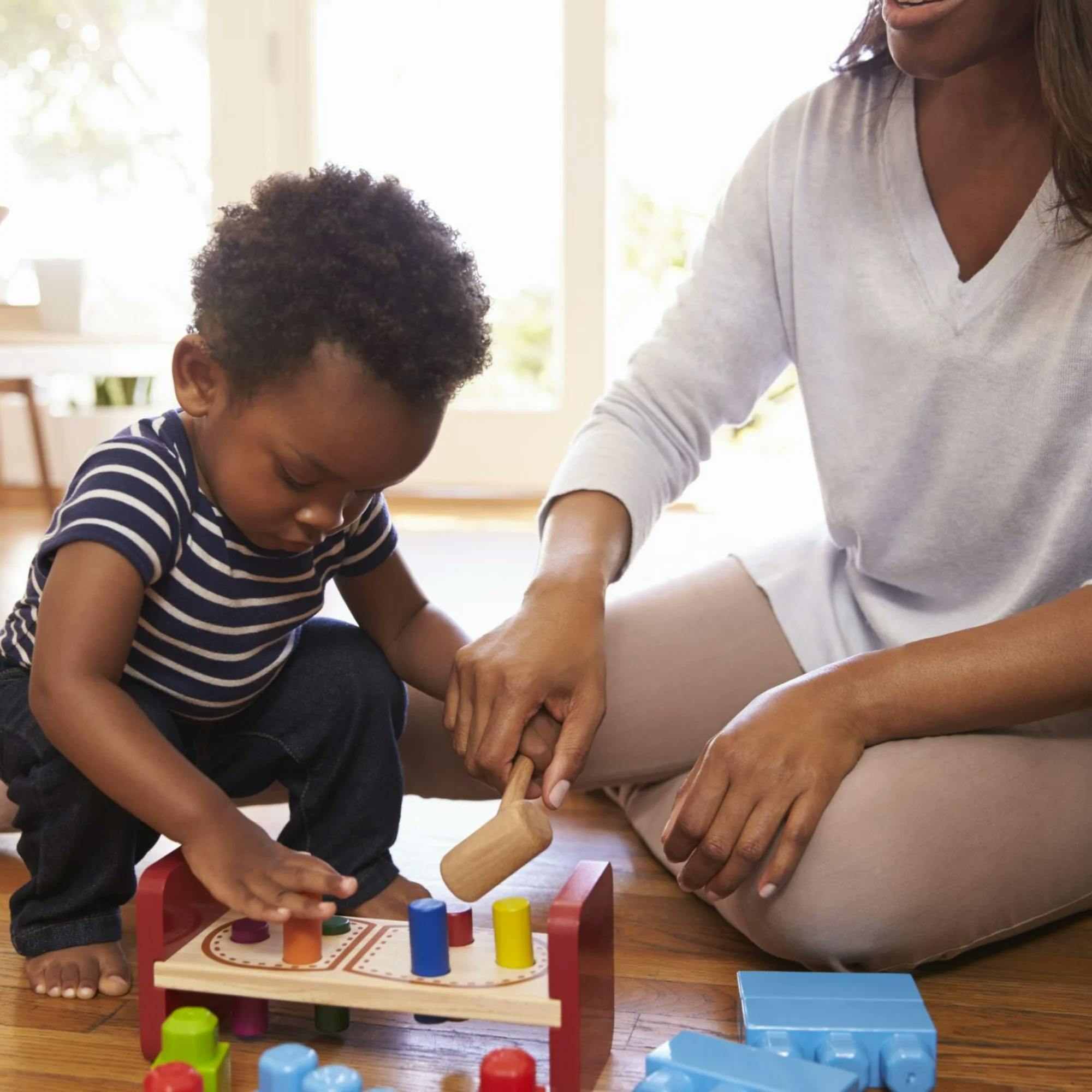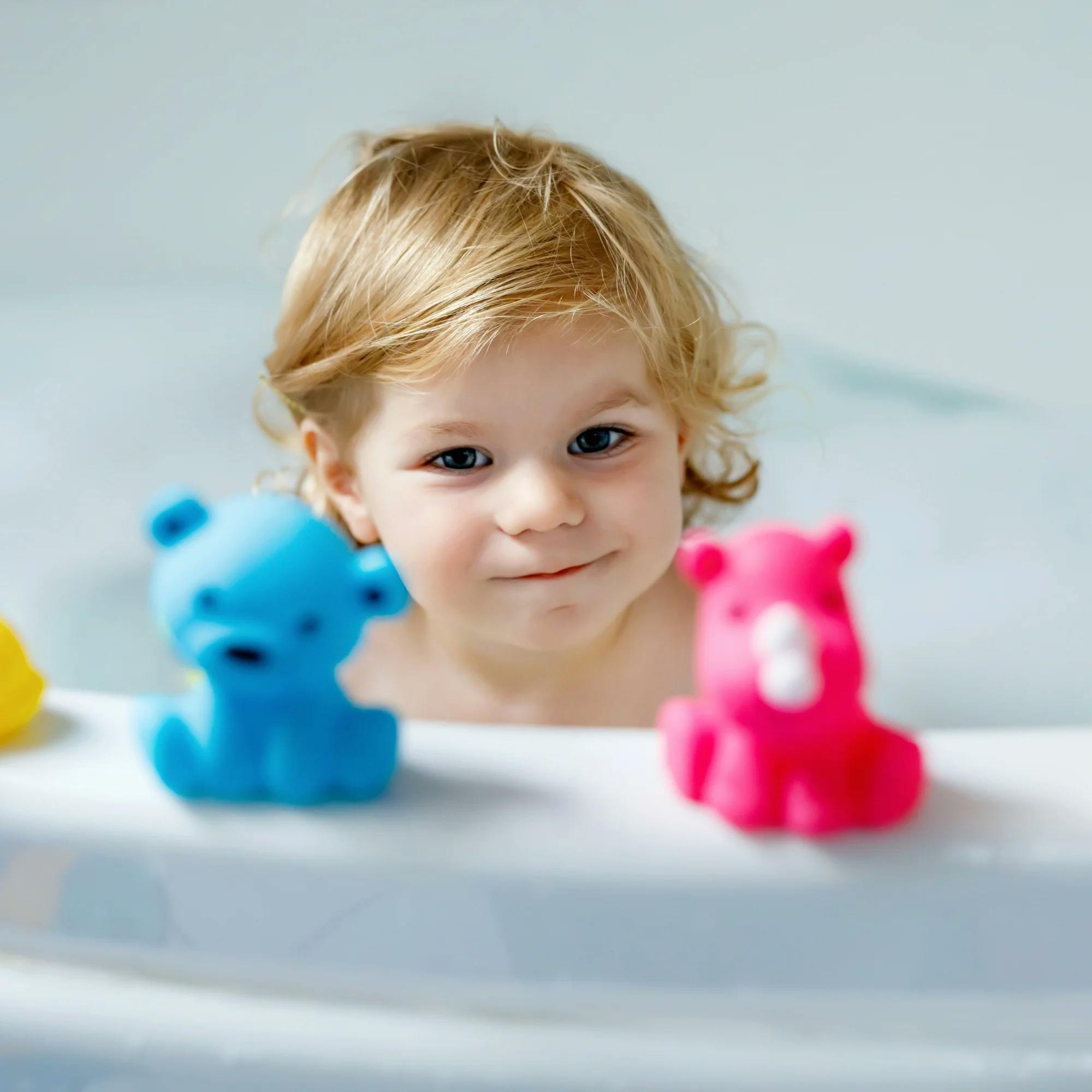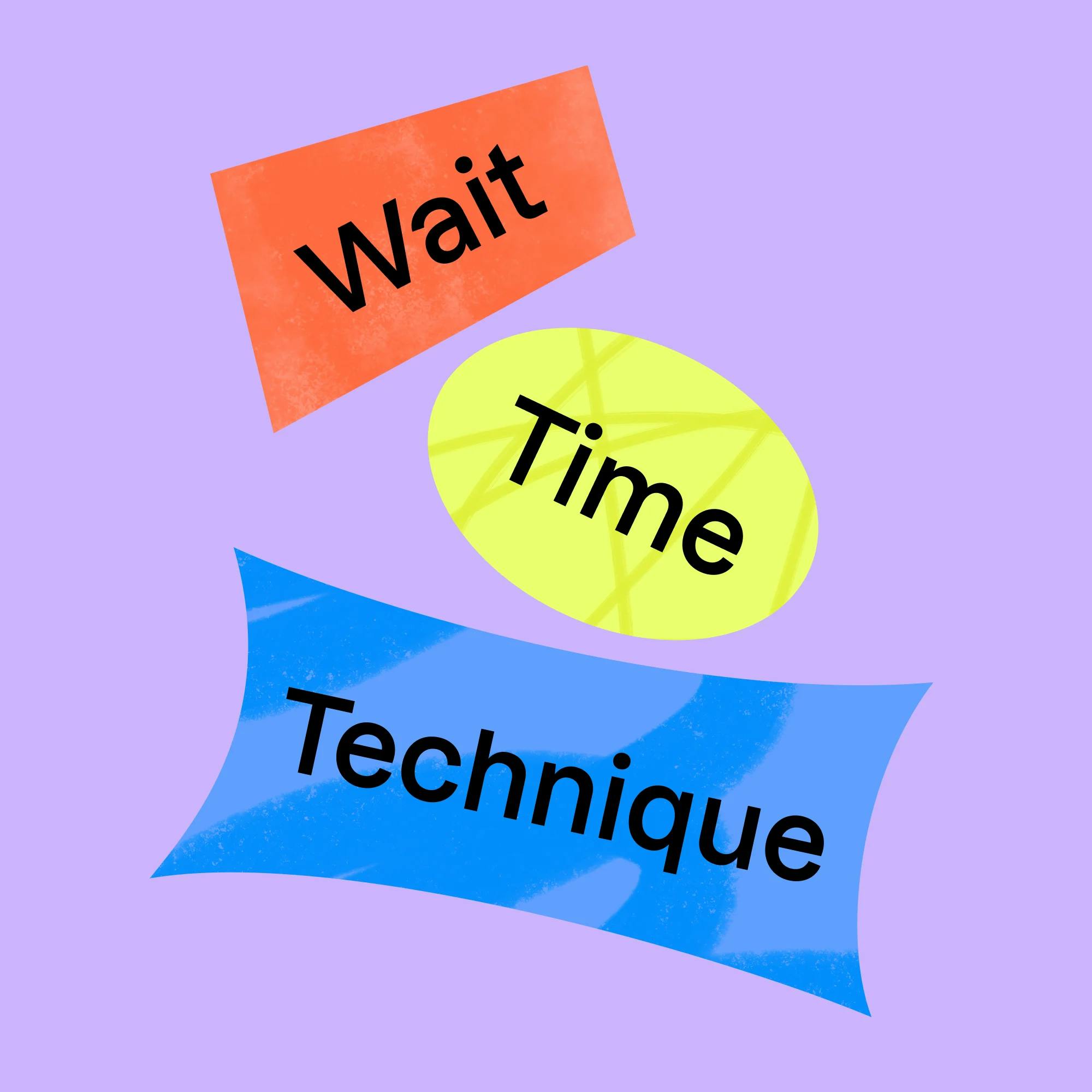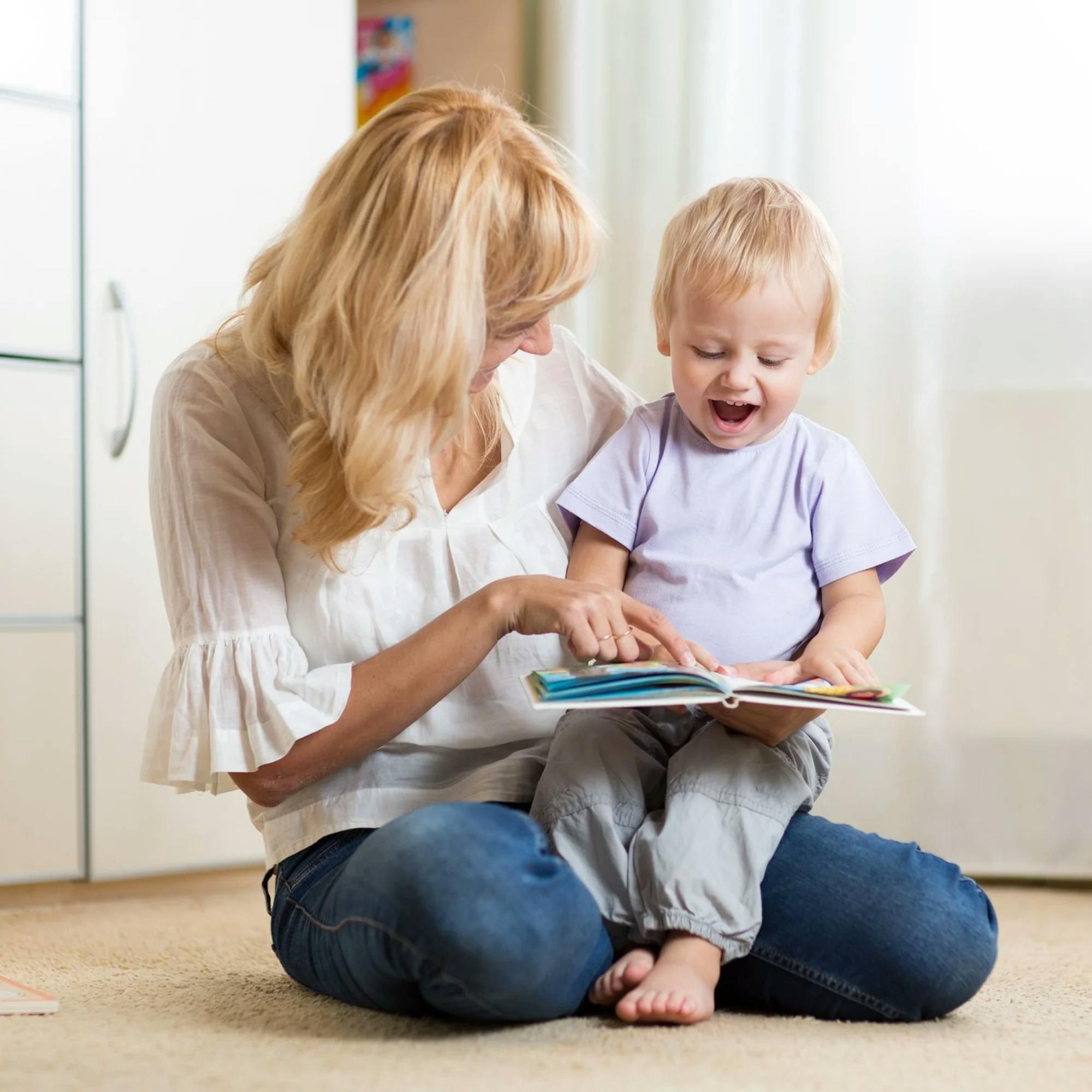If your 1-year-old isn’t talking, take a breath–many toddlers hit speech milestones at different times. What matters most right now is noticing what they are doing: babbling, pointing, making eye contact, or understanding simple words. These are all early signs that your child is building communication skills, even if words haven’t appeared yet.
Speech-language pathologists often hear parents ask whether it’s “normal” if their 1-year-old isn’t talking. In many cases, it can be. But if your toddler isn’t babbling, doesn’t respond to their name, isn’t using gestures, or you have concerns about development (including possible early signs of autism), it’s a good idea to check in with your pediatrician or a speech therapist. You don’t need a diagnosis to get support, and early help can make a meaningful difference.
There’s a lot you can do for your toddler at home, too. Simple, everyday strategies like modeling words, playing together, describing actions, and reading aloud can help build your child’s language skills while you monitor their progress.
Let’s take a closer look at typical milestones for 12- to 24-month-olds, how to understand early speech delays, and what steps to take if your 1-year-old isn’t talking yet.
Curious or concerned?
Our free screener is tailored by age and covers all areas of speech, language, and feeding. Find out if your child might need speech therapy.
 Screener for children
Screener for childrenMy 1-year-old isn’t talking but is babbling: What does that mean?
If your 1-year-old isn’t talking yet but is babbling, that’s actually a very encouraging sign. Babbling is one of the earliest building blocks of speech. It shows that your child is learning how sounds work long before real words appear.
Why babbling is a positive sign
Babies typically start babbling around 4 to 6 months, and their babbles grow more complex over time. Speech-language pathologist and mom of two, Alexis Irazoque, M.S., L/SLP, says, “When your baby babbles, it means their brain and mouth are practicing the skills needed for speech!” Every “ma,” “ba,” and squeal is part of their journey toward words.
By around 10 months, many babies begin using “conversational babbling,” where their sounds start to mimic the tone and flow of adult conversation. They may pause, change pitch, or “talk” as if they expect you to answer. This is a big step toward beginning to talk.


Typical development vs. when to watch more closely
If your 1-year-old is babbling, making eye contact, pointing, and responding to you, those are strong signs that their communication is developing on track, even if actual words haven’t started yet, says Irazoque. Many toddlers go from babbling to saying first words at around 12 months, but it can happen a little earlier or later, depending on the child.
However, it’s helpful to keep an eye on a few things. You may want to talk with your pediatrician or a speech therapist if your child:
Has trouble imitating or making sounds
Doesn’t use gestures like pointing, reaching, or waving
Does not try to imitate your words (around their first birthday)
Doesn’t seem to understand what’s being said or doesn’t respond to their name
Seems frustrated when trying to communicate
These can be early signs that a child may need extra support.

What if my 12-month-old isn’t talking but understands what I say?
If your 1-year-old isn’t talking yet but seems to understand what you say, that can be a good sign! Language development is made up of two parts: expressive language and receptive language.
Expressive language refers to how a person communicates their thoughts, feelings, and ideas. We typically think about communication in terms of using words, but nonverbal language is communication, too! Pointing, gesturing, and using signs are all part of expressive language. Having an expressive language disorder makes it difficult for a child to express what they want, need, or feel.
Receptive language is what a person is able to understand of the words spoken to them. For example, if a parent says, “Stop!” or “Come here!,” the child has to understand the meaning of those words in order to respond appropriately. Children who are delayed in receptive language have trouble understanding conversation and knowing how to respond when someone tells them something. This can make communication difficult between a child and caregiver.
Some children’s receptive language skills may be more advanced than their expressive language skills. In this case, you may notice that your toddler understands and can nonverbally respond to what people say to them.
For example, your child may be able to follow directions like “Bring me your ball.” Or they can point to their feet when you say, “Where do your shoes go?” However, they may not be using words to communicate clearly.
If your 1-year-old seems to do well with understanding words, their receptive language skills are likely on track. If they seem to be a “late talker,” that might be a sign of an expressive language delay or a speech delay.


Can you see signs of autism in a 1-year-old?
Some early signs of autism can show up around 12 months, but it’s important to remember that every child develops on their own timeline.
At this age, most toddlers will look where you point, check back in with you, and use early communication skills like babbling, waving, or smiling back.
An autistic 1-year-old may communicate differently. You might notice things like very little babbling, limited gestures like pointing or waving, not responding to their name, or seeming to “tune out” when you point to something. As Irazoque explains, “These signs don’t mean something is ‘wrong.’ They’re simply early differences in how a child connects and communicates.”
A speech delay does not automatically mean autism. Autism involves a pattern of differences, not just one skill area.
It’s also helpful to know that a speech delay does not automatically mean autism. While many autistic toddlers have delays in spoken language, plenty of children have speech delays without autism. Autism involves a pattern of differences, not just one skill area.
If you’re noticing several signs or have a gut feeling that something is different, it’s always OK to bring it up with your pediatrician. Early conversations can help you get support, reassurance, or a referral to someone who can take a closer look. While autism can sometimes be diagnosed at age 18 months or younger, by age 2 most diagnoses performed by qualified professionals are reliable. However, some children don’t receive a diagnosis until they’re older.


Now, let’s look at some of the communication skills that should develop at 12 months, 18 months, and 24 months old.
Milestones for toddlers ages 12 to 18 months
Receptive language skills (12-18 months)
Responding to their name
Following simple one-step directions, such as “Come here,” “Sit down,” “Give me _____.”
Playing: As a general rule, your child should be able to engage in some kind of a play activity for at least 1-2 minutes before switching tasks. This focused attention allows for more chances to use words and interact back-and-forth with another person. For example, when reading, your 18-month-old should be able to sit long enough to engage with you and the book. They may even begin pointing to pictures in the book when asked.
Playing with objects: In this stage, your child should begin to play with and use objects appropriately. For example, they may hold a phone up to their ear or pretend to drink from a toy cup. As your child begins to use objects for their intended purpose, it means that more imaginative and pretend play skills are just around the corner.

Expressive language skills (12-18 months)
First words: Children typically say their first word somewhere around 12 months old. However, it could be a little earlier or later. You may begin to hear the word "no" pretty often from your 1-year-old, as they express their newfound independence.
Spontaneous utterances: Children learn to imitate the sounds and words you say before producing them on their own. While toddlers should still be imitating new words, they should begin to say words spontaneously as well. For example, an 18-month-old should be able to say something like “milk!” when thirsty, or “ball!” when they want to play. They’re beginning to understand that communication is key to getting what they want.
Consonant sounds: Your toddler should start to use several different consonant sounds in their words or babbles. The earliest developing sounds include /b/, /p/, /m/, /n/, and /d/. Eighteen-month-olds should be able to produce most of these consonants by themselves.

Milestones for toddlers ages 18 to 24 months
Receptive language skills (18-24 months)
Comprehension skills: Between the ages of 18 months and 2 years old, your child should undergo a big jump in their comprehension abilities. Toddlers should be able to understand at least 50 different words, even if they can’t say all of them. You can observe this by watching how your child responds to simple directions and how well they identify objects. If you’re talking about shoes or a dog, your toddler should be able to point to those things.
Playing appropriately: You should see your toddler start to play more appropriately with items, such as using two objects together: pretending to mix a spoon in a bowl, or giving a baby doll a bottle. Similarly, you should see your child start to use objects toward themselves and others. Your toddler may pretend to feed you or brush your hair.
Eye contact: As you play with your toddler, they should be making consistent eye contact with you.


Expressive language skills (18-24 months)
More vocabulary: By 18-24 months, your child should be saying at least 5-10 words regularly and spontaneously. They should also continue to imitate words they hear. Some simple words your child may use to ask for things include “more,” “help,” “eat,” and “go.”
Consonant-vowel combinations: When your child imitates or uses words, they may use different combinations of consonants and vowels. For example, you may hear a consonant-vowel (CV) production, as in “go,” or an approximation of the word boat as “bo.” You may also hear consonant-vowel-consonant-vowel (CVCV) productions, like “wawa” for water. And finally, you may even hear some emerging consonant-vowel-consonant (CVC) productions, like “pop” or “mom.” As your child grows, their attempts at words will begin sounding more and more like true words.
Two-word phrases: Some toddlers in this age range will begin to use very simple two-word phrases, like “I want,” “Give me,” or “More please.” Most children will meet this milestone at, or just past, age 2 years old.
If your 1-year-old is not developing some of these skills, this could be a sign of a language or speech delay. Take a look at the communication milestones for birth to 12 months, too, to see how they’re doing with these skills.
Find a speech therapist for your toddler
If your 1-year-old isn’t talking or you’re worried about their progress, it’s always OK to ask for help. A pediatrician or speech-language pathologist can take a closer look, explain what’s going on, and guide you toward the right support. And the good news: early intervention makes a big difference. The earlier a child starts speech therapy, the sooner they can begin gaining language! Language development builds skill by skill, much like a staircase. You have to take each step one at a time to make it to the top. If a child doesn’t develop the skills that are next in line for them, they won’t be able to meet the skills that come after.
The earlier a child starts speech therapy, the sooner they can begin gaining language skills.
To find a speech therapist, start by talking to your child’s pediatrician. They will likely have some recommendations. They can write a script for speech therapy if necessary.
You can also call speech therapy practices yourself. They can walk you through the steps for beginning therapy.
Speech therapy starts with an evaluation. This helps the speech therapist understand your child’s current communicative strengths and weaknesses. This is a great time to talk to the speech therapist about what you see at home and your goals for your child.
Most children have speech therapy sessions one to two times per week. The length of time in treatment can vary. Working closely with your speech therapist and practicing often at home can help your child make progress faster.
Looking for a speech therapist?
Teletherapy makes it easy. We serve families with a range of speech, language, and feeding needs across the U.S. Get started today!
 Find a speech therapist
Find a speech therapist4 ways to improve your child’s speech at home
You may be wondering what you can do at home to help your toddler with their speech and language. Good news: There is a lot you can practice! And it doesn’t require any big changes or expensive materials. Communication practice can happen during the simple, everyday interactions you have with your child.
1 Get down to their level and play!
Many people don’t realize that play is a huge part of a child’s development. Did you know that play mimics communication? When two people play together, one person takes a turn, then the other person, and so on. These back-and-forth actions are similar to communication.
Taking the time to play with your child can make a big difference in their speech and language development. If you’re not sure where to start, try these using these fun and simple toys for 1-year-olds.
2 Make time to read together every day
Spending time reading with your little one offers amazing benefits for their communication skills. Children who hear one book a day are exposed to 78,000 extra words per year. How incredible is that?
Reading together allows your child to learn more words, understand how sentences are structured, and even increase their phonological awareness skills. This refers to a child’s ability to recognize the sounds that make up words and their meanings. These speech and language abilities are linked to a child’s school success as they grow older.
Plus, reading together helps strengthen the bond you have with your child. So make storytime part of your daily routine!
Quick demo: How to read a book to your child like a speech therapist
Watch here3 Practice imitation skills
Imitation abilities are also important for a child’s speech and language development. If your child isn’t yet mimicking any sounds, spend some time practicing animal sounds, or the sounds of trains and cars. They tend to be fun and motivating for toddlers to copy!
Once your child is imitating these sounds, you can move onto speech sounds such as vowels and consonants–think simple babbles like “ma-ma.” As your child improves in this area, you can move on to simple word imitation.
If you’ve tried all of this and your child is still struggling with verbal imitation, try gesture imitation. Children have to learn to copy gestures and movements before moving on to speech. These can be simple gestures such as waving, blowing kisses, and clapping hands.
4 Model language for your child
One of the simplest and most effective things you can do for your kiddo is to model, or demonstrate, language for them. It’s easy: Just talk to them often, even if they don’t respond to you. Children learn so much from the people they spend the most time with. Your child can learn words, the meaning of words, and how to pronounce them simply by watching and listening to what you do!

Frequently asked questions (FAQs)
Why isn’t my 1-year-old talking yet?
Many 12-month-olds say few or no words. That can be normal, especially if they're babbling, making eye contact, pointing, and understanding what you say. These are all signs that communication is developing. If you’re noticing very limited babbling, gestures, or response to their name, or if your child hasn’t said their first word by 15 months, check in with a pediatrician or speech therapist. You can take our free online screener to see whether your child is on track.
My 1-year-old isn't talking but is babbling. Should I worry?
Babbling is one of the best signs that speech is on the way. Babies use babbling to practice the mouth movements, timing, and rhythms of real speech. Many toddlers go from babbling to words between 12 and 15 months. If your child is babbling and showing signs of connection, like pointing at things or responding to you, this is typically a positive sign. If you’d like reassurance or want a clearer picture of your child’s communication skills, try our free screener.
Can you see signs of autism in a 1-year-old?
Some early signs of autism can appear around 12 months. Autistic toddlers may show differences in communication, such as limited babbling, fewer gestures, not responding to their name, or less shared attention. A speech delay alone does not mean autism. What matters is the overall pattern of communication. If you’re concerned, it’s always OK to ask for help. You can schedule a speech evaluation for more guidance.
What if my 12-month-old isn’t talking but understands everything?
If your toddler seems to understand what you say by following directions, responding to routines, or pointing to familiar objects, that’s a great sign of strong receptive language skills. Many 1-year-olds understand far more than they can express at this age. Some simply develop expressive language (spoken words) a little later.
How do I know if my 1-year-old needs speech therapy?
Talk with a speech therapist if your child isn’t babbling, rarely imitates sounds, doesn’t use gestures (like pointing or waving), doesn’t respond to their name, or isn’t meeting the communication milestones for their age. A speech evaluation can give you a clear understanding of what’s going on and what support could help.
Key takeaways
Many 1-year-olds develop speech and language at different rates. Variations (like saying few words) can still fall within typical development.
Early signs of autism at 12 months may include limited babbling, fewer gestures, or not responding to their name. A speech delay alone does not mean a child is autistic.
There are things you can do at home to help your child learn to talk, such as playing together, encouraging imitation, and modeling language.
If you’re concerned about your child’s communication skills, early support from a pediatrician or speech therapist can help identify needs and guide next steps.
How Expressable Can Help
Concerned your child isn't reaching age-expected milestones? Looking for communication support from a professional? Expressable is a national online speech therapy practice serving children and adults. We treat all major areas of communication and feeding, offer flexible hours including evenings and weekends, and accept most major health insurance plans. We’re proud to have earned more than 3,000 5-star reviews from our clients (4.9/5 average).
Our therapy model is centered on parent and caregiver involvement. Research proves that empowering caregivers to participate in their loved one’s therapy leads to better outcomes. That’s why we combine live, 1-on-1 speech therapy with personalized education and home practice activities for faster progress.
Communication is more than words. It’s how we share how we feel and show who we are. We’re here to help you or your child do just that.
 Abby Barnes, M.S., CCC-SLP
Abby Barnes, M.S., CCC-SLP